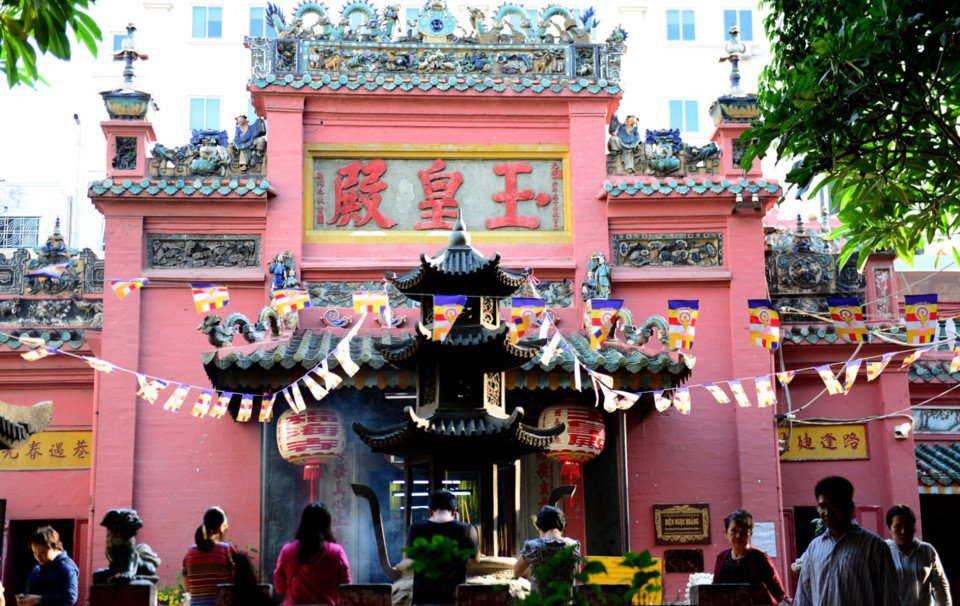
Explore Everything At Jade Emperor Pagoda Ho Chi Minh
Explore Everything At Jade Emperor Pagoda Ho Chi Minh
You may don't know but Vietnam is also popular for some of the top famous pagodas such as One Pillar Pagoda, Thien Mu Pagoda or Bai Dinh Pagoda, the pagoda mentioned in this blog is also one of those.
The Emperor Jade Pagoda was built in the early 1900s to honor the highest Taoist god, the Jade Emperor or King of Heaven, Ngoc Hoang. It is one of the most beautiful churches in Ho Chi Minh City, full of statues of ghostly gods and monster heroes. The beautiful woodcarvings can't be seen because of all the incense smoke in the air.
People come from all over the country and the world to see the pagoda because of its unique designs on the inside and outside, as well as its hundreds of statues and models, wood carvings, and history. On May 25, 2016, at 4:30 p.m., President Obama of the United States went to the Jade Emperor Pagoda.
All kinds of information
73 Mai Thi Luu Street, District 10, Ben Thanh Ward, Ho Chi Minh City, Vietnam. The Jade Emperor Pagoda is just over 4 kilometers north of Ben Thanh Market, which makes it easy to get to from most of the city's main places.
The pagoda is open from 7:00 a.m. to 18:00 p.m. and from 5:00 p.m. to 19:00 p.m. on the first and fifteenth days of the lunar month.
Name of the Jade Emperor Pagoda
The Jade Emperor Pagoda goes by many names, such as:
- Chùa Ngọc Hoàng is the most well-known name in Vietnamese. It is written on a board on the main entry pillar in Điện Ngọc Hoàng. The main gate has Phước Hải Tự written in both Vietnamese and Chinese. The French named it Chùa Đa Kao.
- Temple of the Jade Emperor, Phuoc Hai.
- 玉皇殿 exactly means "Jade Emperor Temple." 福海寺 is written as "Phuoc Hai Tu" or "Luck Sea Temple."
People pray to the Jade Emperor (Ngọc Hoàng) at this pagoda, which is why it is called the Jade Emperor Pagoda or Chùa Ngọc Hoàng. The main gate of the church has the name Phước Hải Tự written in Vietnamese so that everyone can read it.
History
The early 1900s saw the construction of the Jade Emperor Pagoda in Guandong, China, by Luu Minh. Scholar Vuong Hong Sen says that work on the Jade Emperor Pagoda began in 1905 and was finished in 1906. Vo Van Tuong says the tower was built around the year 1900. Others looked into it and found that the Luu Minh started building the pagoda in 1892, but it wasn't finished until 1900, and it wasn't opened to the public until 1906.
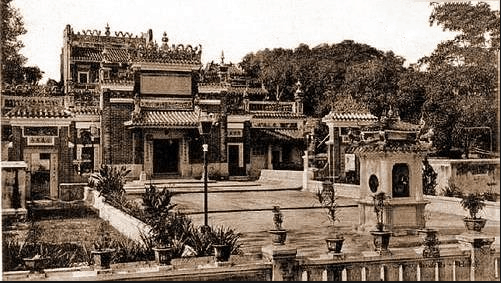
Vuong Hong Sen, a researcher, says that Luu Minh "was a vegetarian, followed the Minh Su religion, wanted to overthrow the Qing Dynasty, and built the pagoda for worshiping and meeting."
The Jade Emperor Pagoda has been owned by the Buddhist Sangha of Vietnam since 1982, and Buddhist teacher Thich Vinh Khuong has been in charge of it.
In 1984, it was given the name Phước Hải Tự, which means "Phuoc Hai Pagoda."
It was rebuilt four times: in 1943, 1958, 1985, and 1986. The historic building, on the other hand, still stands.
The Jade Emperor Pagoda was officially named a historical site by the Vietnamese Department of Culture in 1994.
>>Read more: A Must-read Guide About The Bat Pagoda Before You Go
The fence and the main gate
It is about 6 m wide and 4.5 m high at the main gate of the Jade Emperor Pagoda. It's not a three-aisle gate with several roofs; it's a single-port gate with one roof. This makes the pagoda and its main entrance different from many other churches and pagodas in Ho Chi Minh City.
In reality, there are two gates. Two pink concrete pillars support the bigger one, which has a tile roof. Two stone gates with red Chinese writing surround the smaller gate. The two blinds and the metal grid arch are red and yellow.
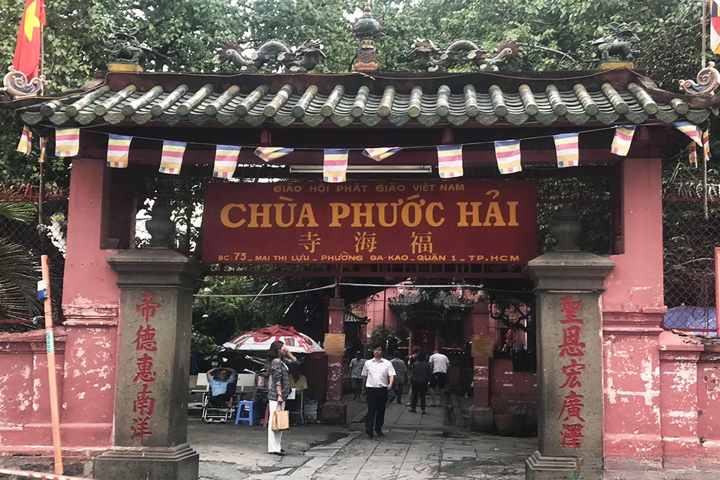
The ying-yan tiled roof bends up and has snail figurines, "two dragons facing a moon (or a pearl)" figurines, and two unicorn figurines on the edges. There is one male and one female unicorn. They protect the pagoda from evil forces and show the balance of Yin and Yang. The whole group of figures is made of clay. The fence and legs are made of pink concrete. The tower is mostly this beautiful color, which makes it both mysterious and stunning.
Red and yellow are the metal gates and the sign that says “Chùa Phước Hải”. Every so often, rows of five-colored Buddhist prayer flags and lanterns are placed at the door.
Yard
The Jade Emperor Pagoda is built on 2,300 m2 of land. From the outside, the garden leads to the main building through the main gate. A place to park motorcycles, Dharmapala Shrine, a lotus and fish pond, a place to burn incense and light candles, a turtle pond, and many green trees are all in the yard.
Dozens of green, old trees that provide plenty of shade are one of the pagoda's draws. Even though Ho Chi Minh City is very hot, tourists feel cool and enjoy the fresh air when they enter the pagoda's yard. Other parts of Saigon are crowded, noisy, and full of buildings and rises. This area is very different.
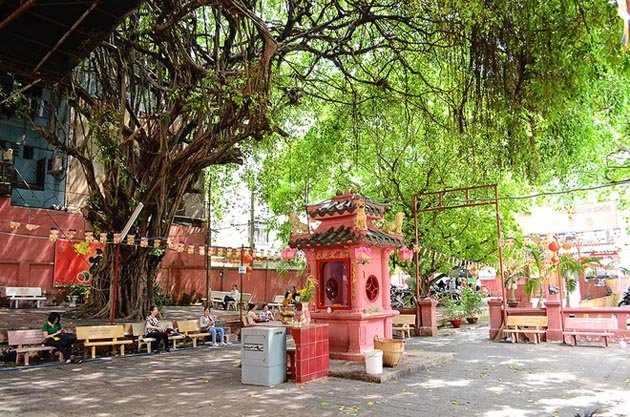
As people walk through the main door, they can see where the motorcycles are parked on the right and left. There is a concrete fence between the parking lot and the backyard. Tourists go through another gate and see some stone chairs where they can sit and relax on their way to the main building.
There is a small shrine to Dharmapala in the middle of the yard. Four pillars hold up the pink, two-tiered tiled roof. The lower roof has four Qilin holding gems in their mouths, and the top roof has lotus flowers and a stupa.
>>Read more: The Huong Pagoda: A Must-See Attraction in Spring

There is a concrete square fish pond surrounding the shrine. In the middle is a smaller hexagonal lotus pond. People can only see lotus buds during the lotus flower season. Behind the pond with fish is a table with lit glass candles that people have brought as gifts, a glass container for incense, and a huge incense burner with a three-tiered roof.
The outside
The main building has three entrances from the outside. The one in the middle is the main and biggest. In front of the main entry is a canopy with two dragon statues and four snail sculptures on top.
The roof is made of green tiles. There are two big lanterns on the roof that look like dragons in green and red. There are two stone panels and two wooden panels on either side of the main door. The blue and red sign with the words CHÙA PHƯỚC HẢI and beautiful wood carvings is placed between the main door and the balcony.
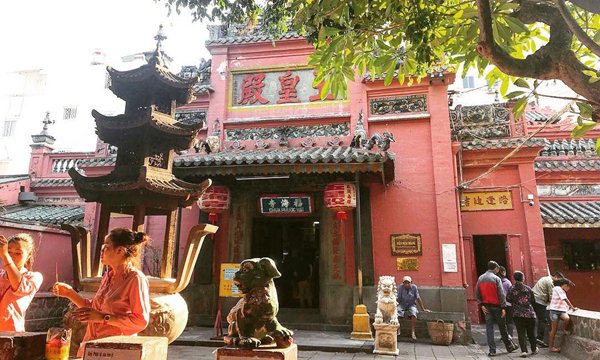
The name of the temple is written in three Chinese characters above the entrance curtain. The outside and roof of the main building are covered with hundreds of flowers, leaves, clouds, waves, and figures of people and animals, such as birds and two big dragons facing the moon (or a gem).
In the right and left rooms, there are two green-tiled balconies and green clay railings that are typical of Vietnamese architecture.
There is something beautiful and strange about the pagoda's pink walls, green roofs, and decorations.
>>Read more: Tips Travel Local Transports Service From Ho Chi Minh City Vietnam
Inside the main building
It has three rooms, or ba gian: one on the left, one on the right, and one in the middle. There is a unique old building in every room.
In the middle room
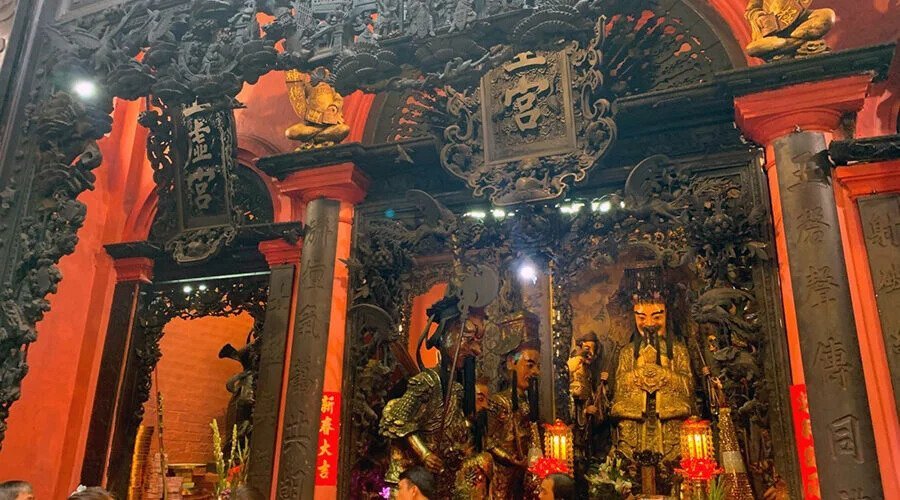
The front hall, the middle hall, and the back hall (main hall) make up the middle room, which is the biggest. People worship the Jade Emperor and other gods in the center room. In the front and center rooms, they sing and plan feasts for important events. Two intricately carved wooden doors make an impression on visitors.
The Middle Room's Front Hall
The altar to the left of the entrance is dedicated to Tudigong, the Earth God and Lord of the Soil and the Ground (Thổ Địa). The altar to the right is dedicated to Menshen, the Martial Door God (Môn Quan Thần).
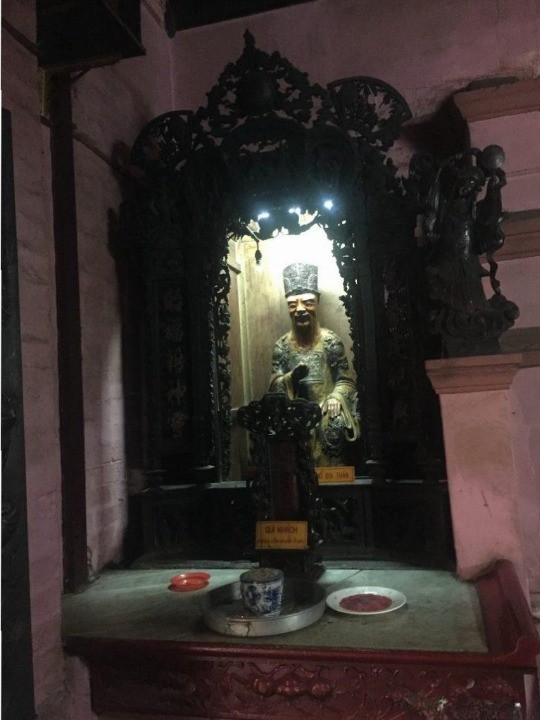
On the left wooden altar is a statue of the Earth God with a long beard, a hat, and a yellow dress with flower and leaf patterns and a round (double happiness) pattern. The statue is smiling and holding gold. They carved two dragons facing a jewel on top of the altar, as well as Chinese characters on the left and right, farmers, fighters, and other figures. A picture of Tudigong, an incense burner, and a light holder plate are set up in front of it.

Both the altar and the altar texts at Menshen have two dragons facing a diamond. Meishen's statue has a long black beard and wears a hat and a costume with patterns of a dragon, clouds, carp, and waves. Dragons are drawn on the blue and white pottery.
There are beautiful carved wooden doors between the front hall and the area where gifts, meditation tools, and presents are sold. The carving in wood shows Nezha fighting devils, which is very different from the beautiful birds, flowers, and leaves above.
Middle Hall of the Middle Room
Pink concrete arches and round and square pillars divide the front hall and middle hall, which are used for prayer. There are incense sticks, rings, bands, Buddhist prayer beads, glass candles, and kerosene bottles in this area for people to look at.
In the entryway to the Middle Hall, there are carvings of a dragon, birds, flowers, leaves, animals, fruits, squirals (or weasels), and a guy with a big belly made out of wood.
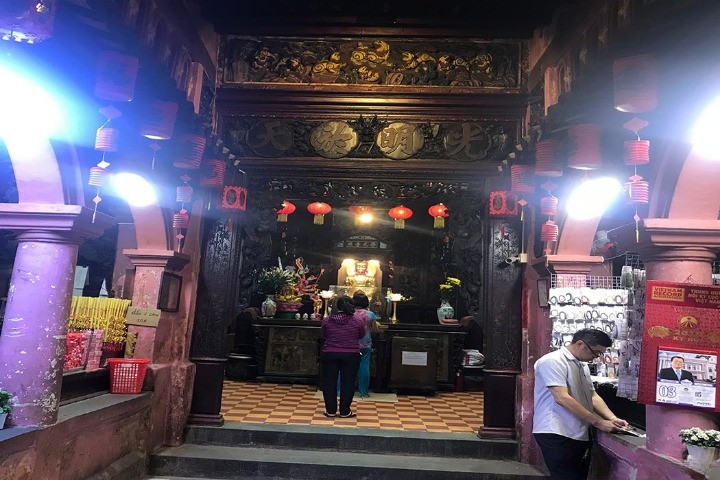
People pray to a golden figure of Medicine Buddha (Phật Dược Sư) on the main altar made of carved wood. In front of the main altar, people pray to the following gods:
- There are three statues in the Western Three Gods series. Amida Buddha (Phật A Di Đà) in a glass box with his two helpers, Padmapani (Quán Thế Âm Bồ Tát) and Mahasthamaprapta (Quan Thế Âm Đại Thế Chí);
- Prince Siddharta Gautama on a lotus flower to the left of the glass box;
- A colorful statue of Cundi (A Phật Mẫu Chuẩn Đề) on the outside left of the glass box.
On either side of the Medicine Buddha altar are two 4-meter-tall paper statues of scary and strong generals who are known for killing dragons and tigers.
Thanh Long General, whose name means "Green Dragon General" in English, has a long beard and dresses in clothes with dragon patterns. He wears flags on his back. He stands on a defeated dragon and holds a gem (or pearl) in his right hand and a sword in his left.
>>Read more: Rent A Car Ho Chi Minh Things To Know For Costs And Effective Drive
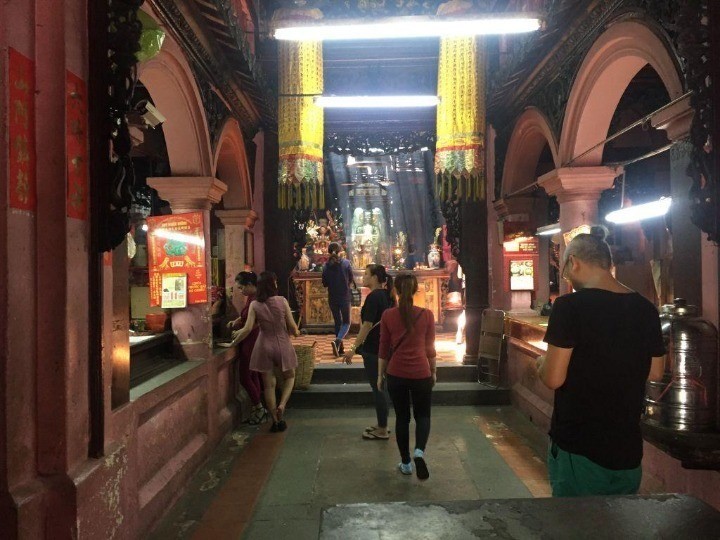
Phuc Ho General, whose name means "General Tame Tiger" in English, has a long beard and a reddish-brown face. He holds a sword in his left hand and a ring in his right. He has a hat on his head and flags on his back, and his clothes have dragon patterns on them. The white tiger is hurt, so he steps on it.
The main hall or back hall, of the middle room ( Chánh Điện )
The Main Hall, which is also called Chánh Điện, is where most people go to pray. There are a lot of statues on shrines in this hall. The Jade Emperor Altar is in the middle, the Zhenwu Emperor Altar is to the left of it, and the Water Moon Palace is to the right.
The Jade Emperor Altar, or Bàn Thờ Ngọc Hoàng
The most important and biggest is a 3 m tall, red-painted, and gold statue of the Jade Emperor sitting on a 1 m high base. The statue wears a crown (mũ bình thiên), is dressed in fancy clothes, and is surrounded by a thick cloud of incense smoke. Other smaller statues that can be found near the Jade Emperor figure are:
- Two Jade Emperor’s assistants named after two stars Crux and Big Dipper (Nam Tào, Bắc Đẩu);
- Hua Tuo (Hoa Đà Tiên Sư), Guan Yu (Quan Thánh Đế Quân), Chinese moon & sun goddesses (thần Nhật Nguyệt), Dragon Queen Mother (Long Mẫu Nương Nương), Taiyi Zhenren ( Thái Ất Chân Nhân);
- Four Big Diamonds (Tứ Đại Kim Cương).
Some of the most interesting things in the Main Hall are the pillars, shrines, and carved wooden panels that have been there for hundreds of years. There were Chinese characters carved into the wooden walls and pillars. People can enjoy looking at the storks, phoenixes, cranes, and flowers that have been carefully made. In the past, the decorations showed scenes from heaven and two Chinese birds making love on a branch.
The Zhenwu Emperor Altar (Bàn Thờ Bắc Đế)
The altar of Zhenwu Emperor (Huyền Thiên Bắc Đế), who is an aspect of the Jade Emperor, is to the left of it. In a sitting pose, the statue with a sword in its right hand, a turtle under one leg, and a snake under the other leg stands for driving demons away.
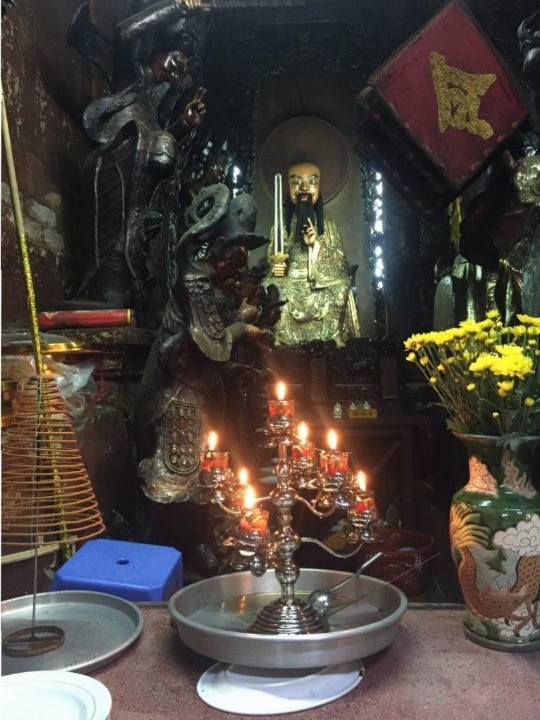
Water Palace of the Moon
There is a Water Moon Palace (Cung Thuỷ Nguyệt) on the right. This is where people worship Cundi (Phật Chuẩn Đề). Two Buddhas worshiped in Mahayana Buddhism are Medicine Buddha, Siddharta Gautama, and Cundi in the Middle Hall and Cundi in the Main Hall.
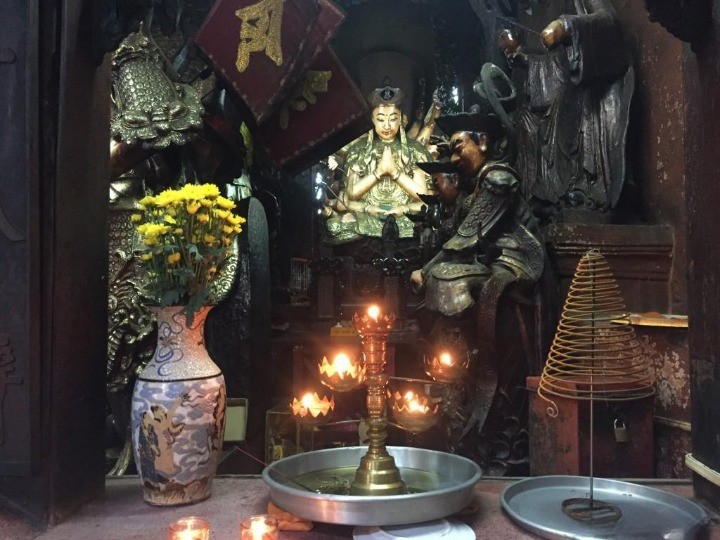
However, they are honored in a Taoist pagoda with many other Taoist gods. The way the statues are set up and the ways people pray at Ngoc Hoang Pagoda are a perfect blend of Taoism and Buddhism.
In the left room
There is another room outside the door on the left side of the Jade Emperor's Room. In the left room, there are three halls:
Jin Hua Hall ( Điện Kim Hoa )
On the other side of the wall is a cute little room filled with ceramic sculptures of Vietnamese mythological and folk religion gods and animals that watch over and help Vietnamese people get married and have babies. An altar made of glass in the shape of a U is used to honor them.
Twelve Midwives, or Mười Hai Bà Mụ, are twelve women in bright clothes who sit in two rows of six and hold babies. The babies run around with the midwives. Every woman stands for a different trait in people, whether it's a good or bad trait (like the woman drinking from a jug). Each number on the 12-year Chinese astrological chart stands for a year. In addition, they teach kids how to talk, walk, and run.
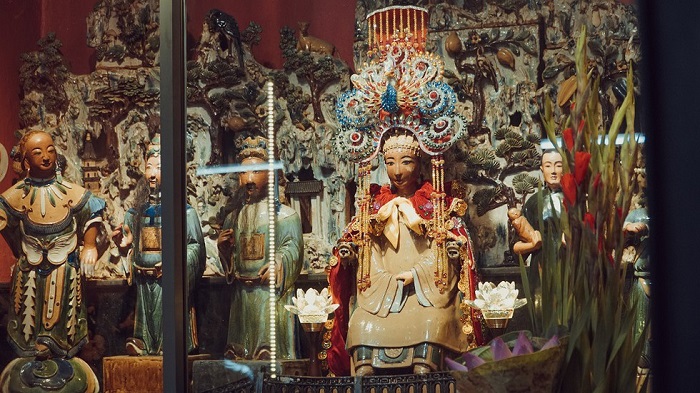
Jin Hua, also known as Kim Hoa Thanh Mau, is the Lordess of Childbirth and Chief of All Women in Vietnamese folk religion. She rules over the room. People also pray to Ông Tơ Bà Nguyệt in the hall. They are the Vietnamese god and goddess of love and marriage.
People who are single often go to Jin Hua Hall to pray for love, and couples who don't have children often go there to pray for children.
Thanh Hoang Hall ( Điện Thành Hoàng )
People pray to Cheng Huan, who is the god of hell, in Thanh Hoang Hall. A large carved wooden painting on the left side of the door to Cheng Huan Hall shows gods punishing bad behavior and rewarding good behavior. Guanyin is holding a child, and Manjushri is sitting on the back of his unicorn.
The carved wooden panels on the left wall called "Ten Courts of Hell (Thập Điện)" show the different kinds of torture that bad people will face in each of the Ten Regions of Hell. The carved wooden panels called "Five Courts of Hell (Thập Điện)" are hanging on the right wall.
>>Read more: Top 10 Car Rental Agencies In Ho Chi Minh | Budget car Rental
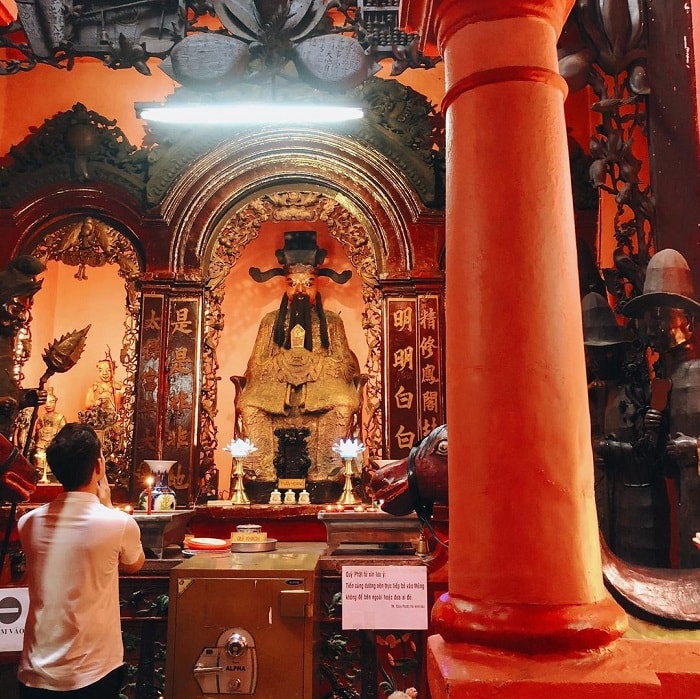
Cheng Huan is the Chief of Hell, Thai Tue is the god of heaven, and Lu Ban is the god of builders and workers. The altar in the back of Cheng Huan Hall is where people pray to these gods. There is a red horse called Horse General (Mã Tướng Quân) and two other horses, Heibai Wuchang (Nhị Vị Song Án, Hạc Bạch Vô Thường, Black and White Impermanence), in front of the altars. They are Cheng Huan's helpers and are in charge of taking the dead's souls to Hell.
People often scratch Horse General, ring the bell around its neck, and say prayers for something. Women wait in line to see the sitting statue of the City God, who is wearing a hat with Chinese characters that read "At one glance, money is given." In a mesmerizing rite, people put money in a box and then rubbed a red piece of paper against his hand and then wrapped it around a candle flame.
The right room ( Gian phải )
The right room has beds and a hall where people honor Lady Buddha and the tablets of the dead. The Lady Buddha Hall has a wooden staircase that goes to the Guanyin Hall. In the Guanyin Hall, people can worship Bodhisattva Avalokitesvara (Quan Âm Bồ Tát), Bodhidharma (Đạt Ma Tổ Sư), Guan Yu (Quan Thánh Đế Quân), Dharmapala (Hộ pháp), and Ancestor Luu Minh, who built the pagoda. The panel was made in 1905 and has characters that stand for "Taoism, Buddhism, and Confucianism," which is a combination of three major faiths.
300 statues and panels made of wood with Chinese characters
Not only does Ngoc Hoang Pagoda have the statues and images listed above, it also has about 300 wooden statues. Buddha (Phật Thích Ca), Bodhisattva Mahasthamaprapta (Đại Thế Chí Bồ Tát), and Bodhisattva Ksitigarbha (Địa Tạng Vương Bồ Tát) are some of the most impressive statues. Others include Leigong (God of Thunder, Thiên Lôi), Hebo (Lord of the River, Hà Bá), Wenchang Wang (God of Culture and Literature, Văn Xương), and Lã TỖ.
The Ngoc Hoang Pagoda has many pannels, altar tablets, and horizontal wooden boards that are written in Chinese. There are 16 straight lacquered boards and 53 couplets that are at odds with each other. Most of them are made of wood that has been carefully cut.
The Shrine of Ong Da
Behind the main building of Ngoc Hoang Pagoda is Ong Da Shrine. Khmer people honored a stone in a small temple. The temple was fixed up after Ngoc Hoang Pagoda was built. It is now called Miếu Ông Đá, which means "Temple of Stone God." A square stone from Thai Son Mountain in Shandong Province, China, is honored in the temple. A fire starter, Đá Thanh Long (Green Dragon Stone), and Đá Bạch Hỗ (White Tiger Stone) are set up in front of the rectangular stone that stands alone.
Things for you to do
The pagoda used to be a Minh Su pagoda. Minh Su is a religion in Vietnam that blends Zen Buddhism, Taoism, and Confucianism. It has, however, changed into a Vietnamese folk religion. The most significant Buddhist holiday that the pagoda observes is the Jade Emperor's Birthday, which falls on the ninth day of the first lunar month.
There are a lot of people at the pagoda in the first lunar month, which is Vietnamese New Year (Tet). They come to pray for money, health, love, and childbirth. People usually bring flowers, incense sticks and rings, and glass candles to the gods. Getting a bottle of kerosene and pouring it over candle holders in the yard or Main Hall while saying their name and the things they pray for.
>>Read more: Private Limousine Ho Chi Minh To Nha Trang | Budget Car Rental
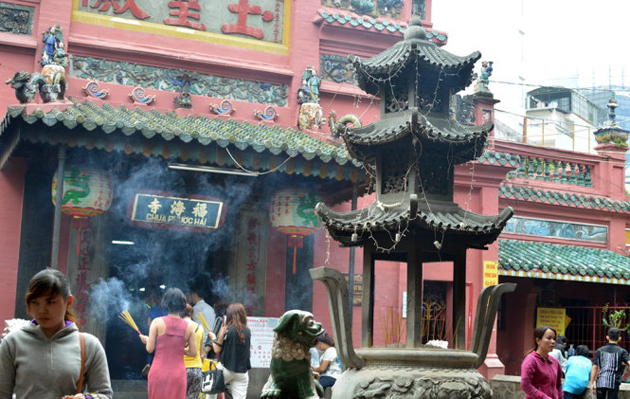
As was already said, people who are single pray in Jin Hua Hall for a good partner, while partners who don't have children pray for them. People scratch Horse General, ring the bell around its neck, and pray for something in Cheng Huan Hall.
Has all the information above that Vietnam Budget Carrental mentioned made you want to explore everything at Jade Emperor Pagoda Ho Chi Minh? If it has, hope you will have the best experience at this place, you can also contact us for our proud services.
